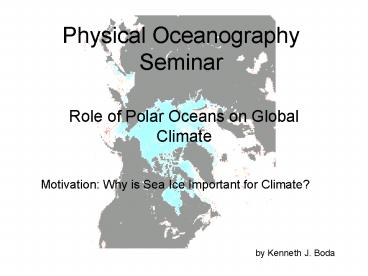Physical Oceanography Seminar - PowerPoint PPT Presentation
1 / 24
Title:
Physical Oceanography Seminar
Description:
Physical Oceanography Seminar. Role of Polar Oceans on Global Climate. Motivation: Why is Sea Ice Important for Climate? by Kenneth J. Boda ... – PowerPoint PPT presentation
Number of Views:99
Avg rating:3.0/5.0
Title: Physical Oceanography Seminar
1
Physical Oceanography Seminar
- Role of Polar Oceans on Global Climate
Motivation Why is Sea Ice Important for Climate?
by Kenneth J. Boda
2
Global Thermohaline Circulation
Solar Heating Max at Equator, Min at Poles
Resulting in
- The Great Ocean Conveyor Belt
Atmospheric Circulation
3
Properties of Seawater
- Density ? the prime mover of seawater
- is a function of
- Salinity S (S?, ?? S?, ??)
- Temperature T (T?, ?? T?, ??)
- Pressure P (P?, ?? P?, ??)
- howevercold water is more compressible than
warm water, know as the Thermobaric Effect
Another property of seawater is d18Ohow much
heavy oxygen is in the water. This shows if
the water has glacial water origin.
4
Major Water Masses
- A water mass is a body of water with similar
properties. - There are 3 major water masses created in polar
regions - Antarctic Bottom Water (AABW)
- North Atlantic Deep Water (NADW)
- Antarctic Intermediate Water (AAIW)
- These are the densest water masses in the world
ocean.
5
Major Ocean Water Masses
6
Definitions
- Isopycnals are surfaces of equal density. When
isopycnals are not horizontal, gravity will
attempt to neutralize this by moving denser water
down. - Fronts are places where two water masses of
different T/S properties meet. - Polynyas are areas of open water in ice covered
seas.
7
Water Mass Modification
- Mixing along fronts
- blends the two water masses, properties of each
(T,S) become averaged. - Modification by the Atmosphere
- Evaporation (S?), Precipitation (S?)
- Solar Heating (T ?), Cold-Wind Cooling (T?)
- Freezing (S?,T?), Melting (S? T?),
- Modification by the Land
- River input, Glacial Meltwater (S?)
8
Antarctic Bottom Water Formation
Ross Sea, Antarctica Sea Ice and Mt. Erebus
(Largest Active Volcano in the World)
9
AABW Formation Water Masses
- Offshore Water Masses
- Circumpolar Deep Water (CDW) a.k.a. Warm Deep
Water (WDW) - warm (1ºC) salty (34.7)
- Antarctic Surface Water (AASW)
- cold (-1ºC) and very fresh (34.2)
- Antarctic Bottom Water (AABW)
- moderately cold (0ºC) and salty (34.7)
10
AABW Formation Water Masses
- Continental Shelf Water Masses
- High Salinity Shelf Water (HSSW)
- Very cold (-1.8ºC) very salty (34.8)
- Low Salinity Shelf Water (LSSW)
- Very cold (-1.6ºC) moderately salty (34.5)
- Ice Shelf Water
- Wicked cold (-2.0ºC) moderately fresh (34.4)
11
Latent Heat Polynya Dynamics
12
(No Transcript)
13
AABW Production
14
North Atlantic Deep Water Formation
Labrador Sea, between Canada and Greenland
15
North Atlantic Deep Water Formation
16
Sensible Heat Polynya Dynamics
Violent-mixing the period when the surface
buoyancy forcing associated with the seasonal,
synoptic meteorology, having exceeded some
critical level, initiates convection at the
preconditioned site
Sinking and spreading the long-term,
post- forcing restratification of the water
column
Preconditioning preconditioned when there exists
a laterally extended deep region of relatively
weak vertical density stratification capped by
a locally shallow Thermocline, also known as
doming of isopycnals
17
A time series of Deep Convection
18
Great Salinity Anomaly
- A decadal event where an anomalously low-salinity
water mass (.1 psu) in the upper layers (surface
500m) of the ocean was observed to travel
cyclonically around the subpolar gyre of the
North Atlantic Ocean for 14 years.
19
Great Salinity Anomaly
20
Hypothesized Causes of the GSA
- Advective Hypothesis A 250 nm eastward shift
of the upper-ocean T-S structure, a physical
movement of water masses and fronts (Pollard and
Pu, 1985) - Arctic Oscillation Hypothesis an anomalous high
pressure cell forms over Greenland which
accelerated transport ice south through the Fram
Straight (Dickson, et al. 1988) - Runoff Hypothesis Anomalously high annual
river runoff from North America into the Beaufort
Sea moved to Fram Straight by the Transpolar
Drift Stream (Mysak, et al. 1990)
21
Great Salinity Anomaly Chart
22
Impact of GSA on Climate
- GSA appeared to play a crucial role in the
formation of large sea-ice anomalies in the
Greenland and Labrador Seas, a 16 month lag of
ice max follows observed salinity minima. - GSA caused the suppression of deep convection,
and hence deep water formation in different parts
of the northwest Atlantic.
23
Deep Water formation and Thermohaline Circulation
- NADW formation has been hypothesized to be a
pump that drives global thermohaline
circulation. - If NADW formation is shut down (by an event such
as the Great Salinity Anomaly) the result could
affect the entire global climate.
24
Great Salinity Anomaly Discussion































